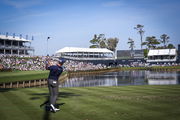
Imago
Composition of silhouette of male golf player over landscape and blue sky with copy space. sport and competition concept digitally generated image. Copyright: xx 1451962

Imago
Composition of silhouette of male golf player over landscape and blue sky with copy space. sport and competition concept digitally generated image. Copyright: xx 1451962
After Min Woo Lee scored the lowest score (63) in the opening round of the 2025 Rocket Classic, he reflected on his experience: “I didn’t feel great on the course, especially at a place where hitting into the rough means you have to hack out.” This bold statement stands out, considering the Detroit Golf Club provided a friendlier environment for PGA Tour pros, with an average of 2.9 strokes under par on the first day. The 1x Tour winner’s comment, however, caught the attention of two industry analysts discussing what constitutes “real golf.”
Watch What’s Trending Now!
On a recent episode of Fried Egg Golf, Andy Johnson and Brendan Porath discussed Lee’s assessment of the course. Porath remarked, “That’s a tough quote. It’s a tough quote for non-signature events, tough quote for Detroit Rocket, tough quote for Min Woo Lee.” Johnson agreed, stating, “It’s awful. I mean, not necessarily for Min Woo Lee, and I think what it underlines is, I don’t understand how these guys can say we shouldn’t roll the ball back because the reason you can hit greens from the rough at places like Detroit is you’re driving at 350 yards, and then every hole is a wedge.”
Their comments are correct: as driving distances increase, scores decrease, especially with the blending of science and skill in today’s power-driven game. The statistics are clear: Kevin Roy and Aldrich Potgieter both topped the leaderboard at the 2025 Rocket Classic with bogey-free rounds of 10-under-par 62. Roy’s impressive performance on the 578-yard 17th hole featured a 300-yard drive, a 288-yard second shot, and a chip from the rough that dropped in from 30 feet.
ADVERTISEMENT
So, are low scores a sign that the PGA Tour is getting easier for the pros? Johnson continues, “This week at Rocket is not real golf. It is just take out the driver, ship it up there, and then chip it onto the green, and who can make more putts? This is a joke.” And the stats at the Detroit Golf Club tell us that much. With four easily reachable par 5s and minimal penal areas, the winning score has been -23 or better in four of the last six years. This week in Detroit, focus on skilled putters who excel with wedges and are strong par-5 scorers.
Kevin & Aldrich lead the way after claiming a new course record. #RocketClassic pic.twitter.com/UiuvxKk9dI
— Rocket Classic (@RocketClassic) June 27, 2025
In 2019, Adam Scott echoed his concerns, stating that shorter layouts like Colonial and Harbour Town prove that length does not equal challenge. Scott remarked, “If you require us to shape tee shots to get it in play, I think we’re going to struggle… We just play straight. Everything straight. And if you had to draw a driver to get it in the fairway, down where you want to be and long, then I think we’re going to see different scores.”
ADVERTISEMENT
Moreover, in 2013, PGA Tour players averaged 288 yards off the tee, while today they average around 300 yards—a difference of just 12 yards. Tour courses should challenge all aspects of the game, including driving accuracy, iron play, short game, putting, and especially course management and mental strength, rather than just focusing on distance. However, in 2022, Patrick Cantlay discussed this issue.
Top Stories
Who Is Charley Hull’s Ex-Husband? Is LPGA Star Currently Dating?

Pro Suffers Disqualification at PGA Tour Q-School After Several Players Withdrew Abruptly

Golf World Feels Sorry for PGA Tour Hopeful as Meltdown Over Q-School Stress Is Caught on Camera

Brooks Koepka Takes up New Role Amid LIV Golf Exit Rumors Reaching Boiling Point

Donald Trump Puts Public Golf Courses on Notice Amid Control Dispute

ADVERTISEMENT
Patrick Cantlay is tired of the Tour’s “bomb it as far as you can” golf courses
In 2022, Patty Ice voiced his concerns about the PGA Tour’s trend of favoring courses that cater to long hitters, or “bombers.” Ahead of the BMW Championship, he remarked, “I’m so surprised that [the Tour hasn’t] figured it out. It just seems like we’re getting more and more of the same bomb-it-as-far-as-you-can golf courses week after week.” Cantlay’s comments highlighted growing frustration among players who feel that course design is becoming less strategic and more reliant on sheer distance.
Cantlay’s critique was particularly relevant as he prepared to defend his title at Wilmington, a course measuring 7,534 yards, which was making its PGA Tour debut. He noted that the trend of lengthening courses often comes at the expense of strategic play, stating, “The way we combat the distance… is by taking all the trees out and playing it 7,600 yards and put the tees way back.” He argued that this approach diminishes the variety of shots required, reducing the game to a contest of who can hit the ball the farthest.
Cantlay, who won the FedEx Cup in 2021 despite ranking 50th in driving distance, pointed out that many long hitters tend to avoid shorter, more strategic courses. He cited examples like Hilton Head and Colonial, saying, “It’s so surprising to me that the golf courses that none of the guys who hit it far… don’t go to” these venues. Cantlay’s perspective reflects a broader debate within golf about balancing distance and strategy in course design. So, maybe Andy Johnson and Brandan Porath aren’t alone in their assessment?
ADVERTISEMENT
ADVERTISEMENT
ADVERTISEMENT
ADVERTISEMENT

